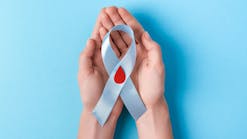Salmonella
associated with microbiology laboratories sickens dozens. The Centers for Disease Control and Prevention (CDC) is collaborating with state public health officials to investigate a multistate outbreak of Salmonella typhimurium infections associated with exposure to clinical and teaching microbiology laboratories. As of April 29, 2011, 73 individuals infected with the outbreak strain of S typhimurium have been reported from 35 states. Fourteen per cent of patients have been hospitalized, and one death has been reported, according to the CDC. The illnesses involve a commercially available S enterica serotype typhimurium strain used in laboratories, and health officials believe students or lab employees may have carried the bacteria to their homes on contaminated lab coats, pens, notebooks, or other items, according to a CIDRAP News report. Some of the sick patients were students or employees in the labs, many of whom reported working with Salmonella. Several of the patients are children who live with a person who studies or works in a microbiology lab. Learn more at CIDRAP.
Armadillos are source of leprosy in southern U.S. A new study shows that some armadillos and people with leprosy in the southern United States are infected with the same bacterial strain, which suggests that the disease can pass between species. In the study, published in the April 28, 2011, issue of the New England Journal of Medicine, researchers identified a unique strain of Mycobacterium leprae present in 25 of 39 patients and 28 of 33 armadillos captured in Arkansas, Alabama, Louisiana, Mississippi, and Texas. Some studies have shown that more than 20% of wild armadillos are infected with leprosy in some U.S. locations. Leprosy, also called Hansen's disease, in humans in the U.S. is rare. According to the study's researcher, there are about 150 cases of leprosy reported in the U.S. each year, and most cases can be traced to other countries were the disease is more common (e.g., India, Brazil). Researchers note that about one-third of new cases developed in people who had not left the country, and most of those people lived in Louisiana or Texas.
Rabies death toll tops 124 in Bali. An outbreak of rabies that hit Indonesia's resort island of Bali in 2008 has since killed 124 people, island officials report. Rabies has been reported on the Indonesian islands of Java and Flores, but Bali was free of the disease for decades until 2008. The World Health Organization (WHO) estimates more than 40,000 people die from rabies yearly, and 10 million people worldwide are treated after being exposed to animals that may have rabies. The number of human rabies deaths is low in the United States compared with the rest of the world. In 2009, 49 states and Puerto Rico reported 6,690 cases of rabies in animals and four human cases to CDC (Hawaii is the only U.S. state that is rabies free). In November 2009, a 55-year-old Michigan man was hospitalized with labored breathing and muscle weakness that rapidly progressed to flaccid paralysis, then death. Rabies was not suspected until a family member reported that several months earlier the patient may have come in contact with a bat while asleep. A diagnosis of rabies was confirmed by CDC laboratory testing, with molecular analysis later revealing that the patient had been infected with a variant commonly associated with the silver-haired bat.
HIV infection raises heart-failure risk. Infection with HIV can increase the risk of heart failure — even in patients with no prior history of heart disease, a University of Pittsburgh School of Medicine researcher says. In addition, as the HIV virus replicates, the risk increases, according to a study published April 25, 2011, in the Archives of Internal Medicine. The study included nearly 8,486 adults, with a median age of 48 years in both HIV-infected and HIV-uninfected subjects. During follow-up, 286 study participants developed heart failure. Rates of heart failure per 1,000 person-years were 7.12 for HIV-infected patients and 4.82 for HIV-uninfected. After accounting for traditional risk factors, the hazard ratio for heart failure with HIV was 1.81.
New studies
Researchers develop non-invasive test for gastric cancer. Certain proteins excreted in urine can indicate the presence of gastric cancer, reveals a study published Feb. 18, 2011, in PloS ONE. University of Georgia researchers identified a protein called endothelial lipase that differed significantly in its abundance in urine samples of stomach-cancer patients versus healthy people. Researchers say the computational capability presented in the study for predicting which of the abnormally abundant proteins in diseased tissues can be excreted into urine is a key breakthrough in cancer detection. Using samples from known excretory and non-excretory proteins, the study found that the classification system was more than 80% accurate. The researchers say they eventually hope to develop a method where urine can change the color of a piece of paper to indicate the presence or absence of the protein.
Researchers ID pancreatic-cancer-screening marker. Researchers at the University of Michigan Comprehensive Cancer Center have identified a protein that shows distinct changes in structure between pancreatic cancer, non-cancerous diseases, and normal blood serum. The protein, haptoglobin, is a type of glycoprotein, which also changes from early-stage pancreatic cancer to advanced disease. The study, published online in the Journal of Proteome Research, suggests that a blood test could serve as a potential screening tool to detect pancreatic cancer. Researchers continue to refine the assay, and believe that a similar test could be used for colon and liver cancer, although more work is needed to identify the best markers in those diseases.
Low vitamin D levels linked to more aggressive breast cancers. Breast cancer patients with low levels of vitamin D have more aggressive tumors and poorer outcomes, a new study finds. A team from the University of Rochester Medical Center tracked 155 women who had surgery for breast cancer between January 2009 and September 2010. The team examined blood tests that provided vitamin D levels for all the patients in the one-year period before and after surgery. They also analyzed relevant patient breast-cancer data, such as age, race, cancer stage at diagnosis, menopause status, gene expression, and estrogen and progesterone status. The researchers found an association between low vitamin D levels (less than 32 milligrams per milliliter of blood) and poor scores on every major biological marker used to predict a breast-cancer patient's outcome.
Low vitamin D levels tied to obesity in kids. New research shows vitamin D deficiency is common in American children and is linked with obesity and different types of fat distribution in white and black youngsters. Researchers checked vitamin D levels in 237 healthy obese and non-obese white and black children, aged eight to 18 — most were found to be vitamin D deficient. Low levels of vitamin D were associated with higher body mass index and fat levels, and lower levels of high-density lipoprotein (HDL) cholesterol. Among those with vitamin D deficiency, white children were more likely to have higher levels of fat between their visceral adipose tissue, while black children were more likely to have higher levels of fat just under subcutaneous adipose tissue, the investigators found. The study is published in the May issue of the Journal of Clinical Endocrinology and Metabolism.
Predictive model for progression of CKD. Clinicians may have a new tool they can use to better predict which patients with chronic kidney disease (CKD) will progress to kidney failure, reports Renal and Urology News. American and Canadian researchers have come up with a model using routine laboratory tests that appear to accurately predict progression to kidney failure in patients with CKD stages three through five. Researchers from Tufts Medical Center-Boston utilized a model that incorporates age, gender, estimated glomerular filtration rate (eGFR), albuminuria, serum calcium, serum phosphate, serum bicarbonate, and serum albumin, according to a report in the Journal of the American Medical Association. This model was more accurate than a simpler model that included age, gender, eGFR, and albuminuria.
Blood test finds markers of bladder-cancer risk. A blood test can accurately detect biomolecular markers of bladder cancer resulting from environmental carcinogens. Researchers at Brown University in Providence, RI, reported online Feb. 22, 2011, in the Journal of Clinical Oncology that the blood test measures a pattern of methylation — a chemical alteration to DNA that is affected by exposure such carcinogens as cigarette smoke and industrial pollutants. In a study of 112 bladder-cancer patients and 118 controls, those exhibiting the methylation pattern were 5.2 times more likely than those without the pattern to have bladder cancer.
Measles outbreak in Utah. Health officials in Utah are trying to contain a measles outbreak that may have infected hundreds of people who attended two recent community events, according to CBS News reports. Nine cases in the state have been linked to exposure to one unvaccinated person who contracted the disease in Poland, according to the Salt Lake Valley health department. Epidemiologists have determined that the infected person exposed as many as 1,000 people earlier this month. Nationwide, 84 measles cases have been reported this year, the most since 2008 when there were 140 cases, many of which were traced to an outbreak in Arizona started by a Swedish tourist, according to the CDC. Health officials say outbreaks also have been reported in Minnesota and New Jersey. Europe, especially France, has been hit by a major outbreak of measles, which the United Nations health agency blames on the failure to vaccinate all children.







